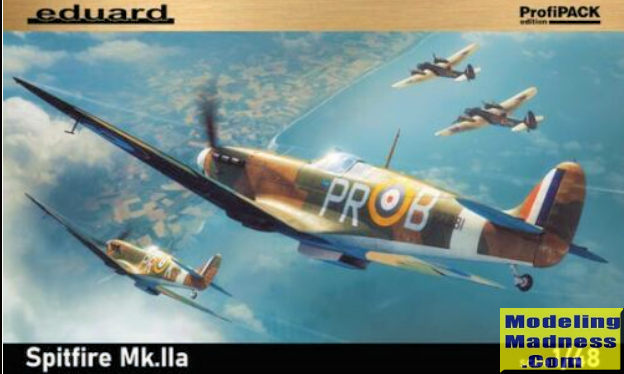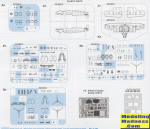
Eduard 1/48 Spitfire IIa
| KIT #: | 82153 |
| PRICE: | ~$50.00 SRP |
| DECALS: | Five options |
| REVIEWER: | Scott Van Aken |
| NOTES: | Profipack |

| HISTORY |
In the summer of 1939 an early Mk I K9788 was fitted with a new version of the Merlin, the XII. With the success of the trial it was decided to use this version of the Merlin in the Mk II which, it was decided, would be the first version to be produced exclusively by the huge new Lord Nuffield shadow factory at Castle Bromwich.
Chief among the changes was the upgraded 1,175 horsepower (876 kW) Merlin XII engine. This engine included a Coffman engine starter, instead of the electric system of earlier and some later versions of the Merlin, and it required a small "teardrop" blister on the forward starboard cowling. The Merlin XII was cooled by a 70% to 30% water glycol mix, rather than pure glycol used for earlier Merlin versions.
In early 1940 Spitfire Is of 54 and 66 Squadrons were fitted with Rotol manufactured wide-bladed propellers of 10 ft 9 in (3.27 m) diameter, which were recognisable by a bigger, more rounded spinner: the decision was made that the new propeller would also be used exclusively by the Mk II. This engine/propeller combination increased top speed over the late Mk I by about 6–7 mph below 17,000 feet (5,200 m), and improved climb rate. Due to all of the weight increases maximum speed performance was still lower than that of early Mk Is, but combat capability was far better. The Mk II was produced in IIa eight-gun and IIb cannon armed versions. Deliveries were very rapid, and they quickly replaced all remaining Mk Is in service, which were then sent to Operational Training Units. The RAF had re-equipped with the new version by April 1941. The Rotol propeller units were later supplemented by de Havilland constant-speed units similar to those fitted to Mk Is.
A total of 921 Mk.IIs were built, all at Castle Bromwich.
| THE KIT |

The kit has a very nicely appointed interior and since this is a Profipack kit, there are a number of photoetch pieces to replace or enhance plastic bit. Some folks will use all of these while others will concentrate on the larger bits. I find that some parts to be replaced by p.e. are actually more prototypical when left in plastic, such as the connecting tube between the two oxygen bottles. Others, such as the armor plating are more scale in p.e. and in some cases you have to use p.e. as there is no plastic equivalent. One note is that for this variant, the seats were in bakelite so will be left in a russet color.
Before installing the cockpit
assembly, the modeler will need to decide between open or closed canopy. For
closed, some cutting is needed on the fuselage
All the flight surfaces have
separate controls and the wing has separate tips to accommodate later clipped
wing Spits.
Main wheels have separate
hubs to make it easy to paint the tires. The gear is well done and one can leave
these off along with the tail gear until after painting. There is a separate
cockpit access door and this m ay
be posed open or closed with separate parts for each option. Eduard provides
canopy masks to help you with painting the clear bits. You are also provided
with different props and spinners depending on which markings option you are
using. It appears one prop is a Rotol and the other a deHavilland. While these
planes had VHF radios with no long wire antenna, they did have the IFF antennas
if you wish to add those.
ay
be posed open or closed with separate parts for each option. Eduard provides
canopy masks to help you with painting the clear bits. You are also provided
with different props and spinners depending on which markings option you are
using. It appears one prop is a Rotol and the other a deHavilland. While these
planes had VHF radios with no long wire antenna, they did have the IFF antennas
if you wish to add those.
Instructions are standard
Eduard booklet in color. There are five options in a variety of camouflage
schemes for planes from 609 Squadron, 315 Squadron, 452 Squadron, 312 Squadron,
and 340 Squadron. All are from the 1941/42 time frame. Decals are very nicely
printed and you are provided a complete stencil suite. The decals do not appear
to be the new 'stick and peel' type which I am growing to detest.
| CONCLUSIONS |
Overall, it is a very nice looking kit. While I know it will be fiddly to build and perhaps even frustrating, it is how Eduard is able to provide the greatest level of detail and accuracy. If one takes one's time, it will produce an excellent replica.
| REFERENCES |
https://en.wikipedia.org/wiki/Supermarine_Spitfire_(early_Merlin-powered_variants)#Mk_II_(Type_329)
May 2022
Copyright ModelingMadness.com. All rights reserved. No reproduction in part or in whole without express permission from the editor.
Thanks to Eduard via Tom Cleaver for the preview kit.
If you would like your product reviewed fairly and fairly quickly, please contact the editor or see other details in the Note to Contributors.